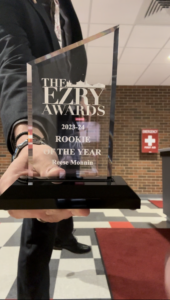Wittenberg has been missing out on millions of dollars in revenue due to students leaving the university before graduation, money that could be put toward construction costs and university bills.
In recent years, freshmen haven’t been returning for a second year or, in some cases, staying from fall to spring semesters. With this, Wittenberg not only loses tuition dollars, housing, food services and clubs, who rely on student involvement fees, also miss out on money had the students stayed.
The university has averaged 77.2 percent retention, students returning for their second year, over the past five years, according to Wittenberg’s 2017 Retention Report. Wittenberg ranks below-average when bench-marked against other schools regionally.
“For instance, for the 2015 entering class, Wittenberg’s retention rate into fall 2016 was 75 percent compared to 84 percent for the NCAC average,” Darby Hiller, Assistant Provost for Academic Affairs & Institutional Research, said. “Wittenberg has been below the average for the past five years.”
Wittenberg’s current tuition and fees total $48,856. If Wittenberg keeps this figure, along with their five-year averages of 530 incoming students, the university would lose over $42 million per cohort, that is, each group of first-time, full-time freshmen entering together for the fall semester of a given year, per year.
“Retention rate impacts Wittenberg’s revenue,” Hiller said. “The higher the retention rate the more revenue Wittenberg can count on in the five-year budget model, which helps in planning for student services and improvements.”
The possible revenue from one class graduating together completely is just about enough to pay off Wittenberg’s highly anticipated HWA Facility. The university could also expect over $100 million in revenue increase from five cohorts to contribute to the five-year budget model if the graduation rate increases from 60 to 80 percent.
The $42 million loss is an estimate, as many students pay tuition and fees with financial aid, which is not revenue for the university. Wittenberg has retained less than 70 percent of those with the highest net tuition and fee revenue over the past five years, according to the annual report, compared to approximately 84 percent of those whom the university doesn’t make as much money on.
Students whose families cannot pay as much for their education also have low retention rates, averaging 68.9 percent over the past five years.
Wittenberg reached a five-year low with the 2016 cohort when only 51.5 percent of students from the lowest EFC quartile returned for their sophomore year.
Academic Affairs and Institutional Research found that ability to pay is one of the two most important factors related to retention in a memo summarizing the 2017 report. The second-largest factor is academic preparedness.
“It is better for Wittenberg and for our students to retain as many of the incoming class as possible,” Hiller said. “The number one reason to work on retention rates is because we want to see Wittenberg students succeed and to graduate.”
Hiller and Jon Duraj, Associate Dean of Student Success, have found that once students return for their second year, they are more likely to be retained through graduation.
Despite the five-year 77.2 percent average, 91.3 percent of students persist from their second year to their third, and 94.1 percent persist from year-three to year-four.
“After the first year, persistence rates maintain,” Duraj said. “The first decision point is after their first semester.”
Fall to spring semester persistence averages 90.8 percent over the previous five years, according to the 2017 Retention Report. It has, however, decreased from 92.7 percent with the 2013 cohort to 87.7 percent for the 2016 cohort.
Recent initiatives for Wittenberg to correct past financial problems through retention and increased enrollment stem from within the university’s newly proposed strategic plan, Renewing the Promise: Wittenberg 2022.
The strategic plan calls for an increase in Wittenberg’s overall headcount over the next five years. Increasing 1,943 students to at least 2,100 by 2022 is expected to generate $6 million more in yearly revenue for the university, compared to current tuition and fee revenue.
According to Renewing the Process, the plan is to “develop and implement a comprehensive retention plan to achieve at least 80 percent first-to-second-year retention and a comparable improvement in four-year graduation rate.”
Students leave their cohort for a variety of reasons, said Duraj. These include academic reasons, health-related issues, conduct dismissals and uncertainty regarding career aspirations.
“To me, it is about student success,” Duraj said. “Retention is just a number. The question is, how do we best support the student?”
Duraj and other departments relocated to Thomas Library to form COMPASS as a way to help students by giving them everything they need to succeed at Wittenberg in one place. Services offered include tutors, student employment, career services and more.
To further prepare students for the challenges of college life, COMPASS has reached out to students to start relationships and provide support before they even began the orientation process, according to the report summary memo.
According to Duraj, this project was in its first year this past summer, and he awaits more numbers to see how beneficial the initial relationships turned out to be.
Some of the students that are reached out to over the summer are those who might have struggled academically in high school.
During the admission process, students are placed into one of eight academic ranks. These ranks are based on high school GPA and standardized test scores, and are used to judge possible academic preparedness. According to the report, academic rank is a significant predictor of retention.
Over 30 students who were in the lowest academic rank of the 2016 freshmen class dropped out after year one, according to the institutional research. Of the 553-student class, approximately 156 did not return to Wittenberg for the 2017 fall semester.
“The goal and intention of the admission office is to admit students who, based on their application for admission and supporting documentation, have indicators of the academic preparation to be successful at Wittenberg,” Karen Hunt, Executive Director of Admission, said.
However, Wittenberg does not require students to report ACT and SAT scores to be admitted to the university and has been that way since at least 2007, according to Hunt. The decision to be test-optional was chosen because university officials believed at the time that high school GPA was the best determining measure of being able to succeed academically.
The university admitted the most students from ranks three, two and then six. Ranks one through four have averaged approximately 55 percent of a given cohort since 2012, yet retain less than 70 percent yearly.
“We admit those students because we want to provide them the opportunity to be successful,” Hunt said. “However, as an institution, we continue to study this to further understand and identify factors that can better predict likelihood to persist to inform the decision regarding admission for borderline candidates.”
Stopping admittance of the bottom two ranks, as they have the worst retention, won’t change anything, said Duraj, as there will just be a new bottom.
On the other hand, Wittenberg has averaged 91 percent year-one to year-two retention with students in the highest academic ranks. This rank, however, only averages 10 percent of the incoming class, which has averaged about 530 over the past five years.
“With any retention issue at any institution, there is no silver bullet,” Duraj said. “Compared to other small, liberal arts schools that are similar, most of the schools are in the same boat.”





